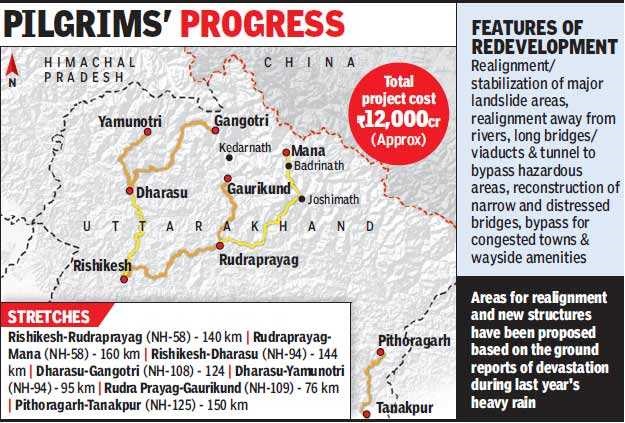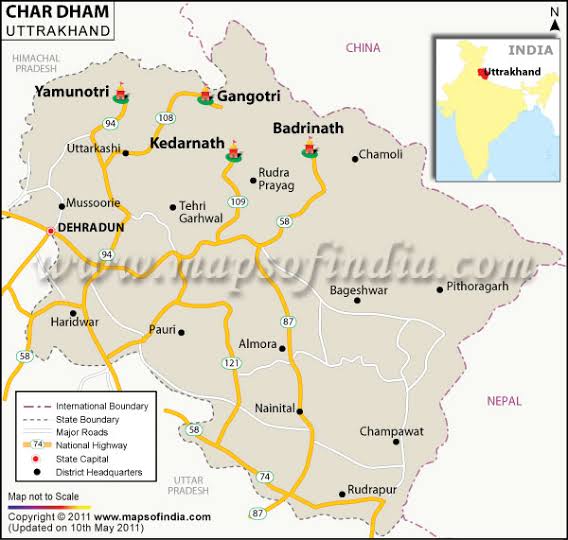Contents
- Inaugration of Chamba Tunnel under Chardham Pariyojana
- Army Commanders’ Conference
INAUGRATION OF CHAMBA TUNNEL UNDER CHARDHAM PARIYOJANA
Focus: GS-III Environment and Ecology, Industry and Infrastructure
Why in news?
Union Minister for Road Transport & Highways and MSMEs naugurated the breakthrough event of Chamba Tunnel under Chardham Pariyojana on 26th May 2020.
Details of the achievement
- Border Roads Organisation (BRO) achieved this major milestone by digging up a 440 m long Tunnel below the busy Chamba town on Rishikesh-Dharasu road Highway (NH 94).
- The breakthrough was completed amidst threat of COVID-19 and nationwide lockdown.
- The construction of tunnel was a challenging task in terms of weak soil strata, continuous water seepage, heavy built up area on top thereby chances of sinking of houses, land acquisition issues, restrictions during COVID lockdown etc.

Significance of the accomplishment
- Rishikesh-Dharasu-Gangotri road in Uttarakhand has a very significant role from socio economic and religious point of view.
- This tunnel will ease out congestion though the Chamba town and reduce the distance by one kilometer and journey through the town will take only ten minutes as compared to thirty minutes earlier.
- BRO is a key stake holder in prestigious Chardham project.
Chardham Project

Char Dham Expressway National Highway is a proposed two-lane (in each direction) express National Highway in the state of Uttarakhand.
Under the prestigious ‘Char Dham’ road project costing about ₹12,000 crore, BRO is constructing 250 km of national highway leading to the holy Hindu shrines of Gangotri and Badrinath.
The proposed highway will complement the under-development Char Dham Railway by connecting the four holy places in Uttarakhand which are:
- Badrinath
- Kedarnath
- Gangotri
- Yamunotri
The roads will be widened from 12m to 24m and the project will involve construction of tunnels, bypasses, bridges, subways and viaducts.
All of these four sites are devoted to a specific deity. Gangotri is dedicated to the Goddess Ganga, Yamunotri is dedicated to the Goddess Yamuna, Kedarnath is dedicated to Lord Shiva and is one of the 12 jyotirlingas and Badrinath, is dedicated to Lord Vishnu.
Himalayan Ecology and Char Dham Project
- The proposed four-lane expressway to Gangotri, Yamunotri, Kedarnath and Bardinath in the hill state has been among the flagship projects of the Ministry of Road Transport and Highways.
- The project evoked widespread concern among environmentalists and has been challenged in the courts.
- Environmentalist groups, led by the Dehradun-based Citizens for Green Doon, had filed petitions last February in the National Green Tribunal (NGT) contending that the project was proceeding without environmental clearances and debris was being disposed haphazardly.
- But the idea of the 900-kilometre road network in the sensitive mountains of Uttarakhand drew scepticism from environmental activists who fear the highways and the tourists they would bring in will be at the cost of the ecological balance.
- In 2019, Supreme Court ordered the setting up of an independent committee to take a view on whether the Centre’s ambitious 900 – kilometre, ₹12,000 crore ambitious Char Dham project to improve road network connecting pilgrimage spots in Uttarakhand, needs to be “revised” to minimise its ecological damage.
- The order has modified portions of the earlier NGT order regarding the constitution of the High-Powered Committee (HPC).
- It would consider the “cumulative and independent impact” of the Char Dham project on the Himalayan ecology.
Impact of developmental projects and other other activities in the Himalayas
- Himalayan region is fragile and vulnerable since it is prone to erosion, landslides and seismic activity and rainstorms lashed the region.
- There is a clear link between climate change and changing rainfall patterns in the Himalayas, with higher possibilities of cloudbursts and “unprecedented” high rainfall over the region.
- There is also a clear link between development projects and “disaster” in the region. For example: blasting to build tunnels and barrages will increase risk of landslides.
- Tourism is being considered as the major engine driving the economy of Himalayan states which has provided valuable economic and livelihood opportunities to the locals and profits for the state governments. On the other hand, air and noise pollution, overbooked hotels, increasing and unregulated tourist footfall, urbanization, haphazard infrastructure non-availability of parking places, and local water and energy security are becoming recurrent problems.
- Over exploitation of natural resources, food insecurity, ill-planned urbanization, loss of indigenous culture, natural disasters, increase in municipal sewage are impacting the Himalayan ecology.
Border Roads Organisation (BRO)
- The Border Roads Organisation (BRO) develops and maintains road networks in India’s border areas and friendly neighboring countries.
- BRO is under the control of the Ministry of Defence since 2015.
- BRO is engaged in road construction to provide connectivity to difficult and inaccessible regions in the border areas of the country.
- Officers from the Border Roads Engineering Service (BRES) and personnel from the General Reserve Engineer Force (GREF) form the parent cadre of the Border Roads Organisation. It is also staffed by officers and troops drawn from the Indian Army’s Corps of Engineers on extra regimental employment (on Deputation).
- BRO has played a very important role in both maintenance of security and in the development of border areas. Most of the development in the North Eastern states of India can be attributed to the relentless work done by the BRO. Socio economic development in the most inaccessible nooks and corners of our country are a result of the infrastructural work undertaken by the BRO.
- BRO works in close association with the Indian Army in cases of natural disasters.
- BRO also undertakes work in neighboring countries such as Afghanistan, Bhutan, Myanmar, and Sri Lanka. Hence, it helps greatly in maintenance of friendly and diplomatic relations.
ARMY COMMANDERS’ CONFERENCE
Focus: GS-III Internal Security
Why in news?
The Army Commanders’ Conference was scheduled for April 2020 and postponed due to COVID-19 pandemic will now be organised in two phases. The first phase of the conference is scheduled from 27 to 29 May 2020 and the second phase in last week of June 2020.
Army Commanders’ Conference
- The Army Commanders’ Conference an apex level biannual event which facilitates conceptual level deliberations culminating in important policy decisions.
- The apex level leadership of Indian Army will brainstorm on current emerging security and administrative challenges and chart the future course for Indian Army.
- The senior commanders will deliberate upon specific issues pertaining to Army formations and Army as a whole.
- It will also deliberate on issues like infrastructure development for capacity enhancement along the Northern borders, review of strategic railway lines, issues related to Border Road Organization projects, and operations, administration and welfare of troops
Similar Conference:
Unified Commanders Conference (UCC)
- UCC is the annual meeting of the 3 armed force services (Army, Navy and Air Force) and the Ministry of Defence to plan India’s long term security.
- It provides a platform for discussions at the apex Level on all the Joint Issues and enables stock taking of the previous year and planning the way ahead for the next year.
- It is chaired by the Defence Minister, Minister of State (Defence) and also attended by the ministry top officials, National Security Advisor (NSA), Chief of Defence Staff (CDS), service chiefs and senior officers of the three services.




